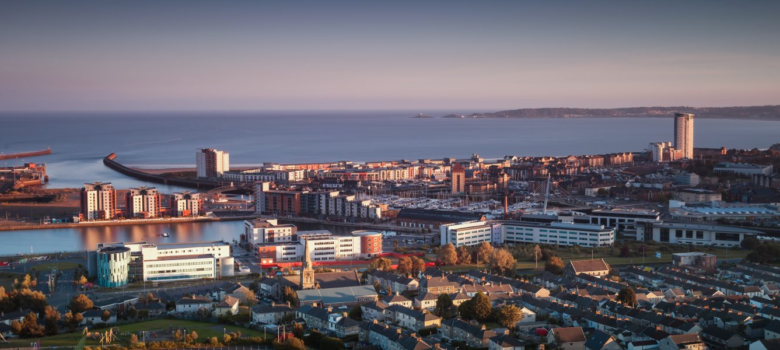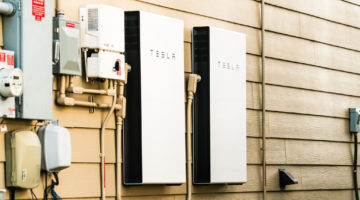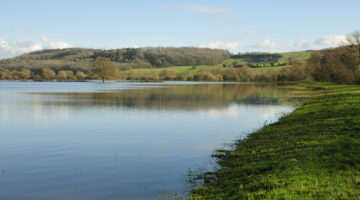
What is the Swansea Tidal Lagoon?
Tidal lagoons work in a similar way to tidal barrages, but differ in that they do not form a barrier all the way across a coastline or estuary. They can be sited offshore, and consist of a (normally circular) perimeter embankment impounding water. Energy production works in two ways: at high tide, a barrier goes up and water rushes into the lagoon through turbines, generating kinetic energy. At low tide, water that has built up inside the lagoon does the same on its way out. The structure looks like a sea wall at low tide, and disappears under the water at high tide. Because of the nature of tides, the tidal lagoons do not produce power consistently, but when they get going they can generate huge amounts. There’s also reliability – unlike other forms of renewable energy, such as wind turbines and solar PV, the energy output of a tidal lagoon plant is entirely predictable.
Because tidal lagoons don’t form a blockade across a large area of coastline, they are less ecologically damaging than barrages. Fish can swim around the structures, and the movement of silt is not as affected. However, people have still raised concerns about the environmental impact.
In theory, the Swansea Tidal Lagoon would be capable of generating 320MW – enough to power more than 155,000 homes. Its life expectancy is around 120 years – twice that of a well performing nuclear plant.
Why has the Lagoon been rejected?
Short answer? Money and politics.
Greg Clark, the UK’s Secretary for Business, Energy and Industrial Strategy (a relatively new section of government which is, in effect, the ruling body for matters of energy and energy efficiency) has deemed the project to be unjustifiably expensive. In his own words, Clark claims that “The inescapable conclusion of an extensive analysis is that however novel and appealing the proposal that has been made is…the costs that would be incurred by consumers and taxpayers would be so much higher than alternative sources of low carbon power, that it would be irresponsible to enter into a contract with the provider.”
It’s all to do with something called a ‘strike price’, which doesn’t get simpler to understand no matter how many Wikipedia articles you read. Without going too far into the nitty gritty details, the lagoon was proposed on the basis of a government subsidy, which would have been paid for by raising consumer energy bills. The extent to which bills would have risen varies greatly – Charles Hendry, the former Energy Minister, conducted an independent review in 2016 that described the cost of the Swansea project to bill-payers as “absolutely miniscule”, estimating it at around 30p a year. Meanwhile, Greg Clark’s much more pessimistic view puts the figure at a £700 average between 2031 and 2050.
There’s also the fact that the tidal lagoon is a pioneering technology, one that does not have the guaranteed results that politicians making the decisions view as a necessity. Depending on who you ask, the perceived insignificance of Wales as a country and an economic power could also have been a factor in the decision. Many regard the rejection of the lagoon as a kick in the teeth for Swansea and indeed the entirety of Wales. The project would have created 1,000 jobs during construction and almost 200 full-time jobs once complete; something all too badly needed in the struggling Welsh Valleys.
What has been the reaction to rejection of the Swansea Tidal Lagoon?
“Securing our energy needs into the future has to be done seriously and, when much cheaper alternatives exist, no individual project, and no particular technology can proceed at any price.” – Greg Clark, the Business, Energy and Industrial Strategy Secretary
“[This is a] vote of no interest in Wales, no confidence in British manufacturing and no care for the planet”. Mark Shorrock, Founder of Tidal Lagoon Power (TLP), who developed the concept for the Swansea Tidal Lagoon
“At the end of the day, any project has to be affordable for consumers.” – Ian Price, Director of CBI Wales
“I realise the disappointment this decision may cause, but ultimately this project did not meet the threshold for taxpayer value.” – Alun Cairns, Welsh Secretary. Cairns faced an unprecedented vote of no-confidence in the Welsh Assembly yesterday, following his failure to adequately support the project. Plaid Cymru, who tabled the motion, have done so on the grounds that the assembly “No longer has confidence in the secretary of state for Wales to deliver major infrastructure projects, following the decision of the Westminster government not to support the Swansea Bay tidal lagoon.”
“Sadly, the UK government’s short-sightedness and complete lack of ambition has thwarted this project, which could have positioned the UK as a world leader in a new global industry.” – Carwyn Jones, the First Minister of Wales
“A government that styles itself as an international leader in tackling climate change has just rejected the opportunity to become the international leader in developing tidal lagoons that produce clean energy day and night, and whose prices would have fallen after this first demonstration project.” – Greenpeace UK campaigner Emma Gibson
Think we missed something? Do you have a different opinion?
Comment below to get your voice heard…













If we had started building tidal lagoons in 2016 we would have some electric energy security. Now we have
rocketing fuel bills. Its clean energy with lifespan for up to 100 years. The technology is low in design and safe unlike
Nuclear,Oil and Gas. The tides are predictable unlike fossil fuels which are supply and demand based.
Gllobal warming will increase tidal heights until we become a non carbon planet.
Therefore giving more output which could be programmed into their design based on predicted rise in sea height.
I actually did the vessel suitability survey of the ship which was going to do the hydrographic survey of the proposed
lagoon site, it was an Impressive area as we sailed around it.
I would say it is now economical to build based on current fuel prices and probably cheaper than other sorts of energy
which are tied to world prices.
With electric cars on the increase the need for renewable environmental sources of electric energy is a priority. Its a
game changer. I walk out my house and my neighbour opposite is charging his car up.
Contact me by email
I live in Formby Liverpool
As energy costs rise surely now is the time to start work urgently on this important project.
didagree
Absolutely diabolical decision. There is no forward vision at all. II have, and am always pushing for this, I really cannot see a negative.
I have just done a spreadsheet on Swansea Tidal Lagoon versus Sizewell C Nuclear Power station, which has just been given the green light. Please see following.
Swansea Tidal Lagoon Sizewell C Nuclear reactor
Estimated cost 1.3 billion Estimated cost 30 billion 23 times greater
Power output 320mw Power output 1670mw 5 times more
Number of homes 155000 Number of homes 6,000,000 Questionable
Life expectancy 120 years Life expectancy 60 years
Waste problems none Waste problems Stored for 110 years
Advantages Numerous Advantages None
Disadvantages Eco damage Disadvantages Numerous including eco damage
Build time 4 years, with
first power
generated in 3 years Build time 15 years plus 4 years longer